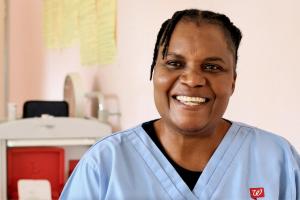Zambia’s polio mop-up reaches almost half a million children in 48 hours
Following a Polio outbreak in Malawi earlier this year, frontline health workers in Zambia distributed 4,5 million Oral Polio Vaccines (OPV) to children under five. During the campaign’s last stretch, or ´mop-up´ phase, teams revisited those who were missed, immunising close to 500,000 in the space of two days.
“This is the busiest campaign we’ve had in years. Just yesterday we identified and vaccinated 50 children at an orphanage we couldn’t reach during the main campaign days”, says Vera Shamaya, a nurse for 22 years and Team supervisor at Palabana Clinic in Lusaka’s Chongwe District.
Outside of cities, mop-ups are a race against time to save lives. “We’re so afraid of Polio now. A child who catches it can be paralysed for life and have no future” adds Shamaya. “With mop-ups, we can catch up on vaccinations where we ran out of time, or couldn’t get transport”.
With the four-day campaign over, it’s time for a two-day nationwide mop-up, a highly critical time for Polio immunisation.
“Our independent monitors have been checking every village in the allocated zone to see if we missed any children,” says Shamaya.
Independent monitors - professionals from outside the health sector, often teachers or agriculturalists - are essential for casting an objective eye on a campaign’s success. They survey every household in a designated area to check if children's nails have been correctly marked after immunization and that the right code is written on their house.
“Where independent monitors fail to see a marker, they report to me and I immediately deploy a team”, says Shamaya. “We’ve just found two children who were missed during the second round and we have to go back”.
A Polio campaign has three phases: pre-campaign, which focuses on preparation and communication; intra-campaign, when key immunisation activities are carried out; and post-campaign, aimed at evaluating the programme. Mop-up is an intra-campaign activity during which teams revisit the homes of missed children.
In this outbreak response, the Global Polio Eradication team opted for a ‘house-to-house’ approach rather than waiting for caregivers to come to a ‘fixed-post’ for vaccination.
While this approach yields high completion rates in densely populated and urban areas, where outreach is fast-paced, it’s another story for the rural landscape.
Zambia has a population density 10 times lower than neighbouring Malawi. In order to leave no child behind, frontline workers sift through every corner of the countryside by motorbike, car or bicycle.
Mable Changala, acting District Health Director in Chongwe says “our designated zone covers facilities as far as 85 kilometres away. Our population is very scattered. Distances are vast, not just between villages, but between each household”. With rural campaigns being so resource intensive, mop-ups are a second chance for meeting vaccination targets.
Dr Barnabas Bessing, Consultant Field Epidemiologist at the World Health Organization, supervises the Polio programme in Lusaka Province. “As a supplementary immunisation activity, the mop-up is one of the pillars of a campaign. It’s an opportunity to analyse setbacks. Children might be hard to reach because of logistics, religious reasons, or conflict. Based on the situation, a mop-up means we can respond with tailored measures,” he says.
Mop-up priority zones also include areas with high population mobility. Should children miss a vaccination round because they are on the farm during the day, mop-up teams will go back in the evening, or for very remote areas, set up camp overnight to see the children early in the morning.
Back at Palabana Clinic, Veria removes an OPV from the freezer for the two missed children identified earlier in the day. Vaccinator Brian and his team have rushed in. Shamaya. briefs them on the location of the household and explains the children were away when they first visited.
A short motorbike ride on tarmac and dirt paths later, they reach the family. It turns out it isn’t two but five children who were missed. They vaccinate, record names, mark the children’s fingers and their house.
After checking in on a second family, Brian jumps onto his motorbike. He’s holding down the clutch but the kickstarter he fixed moments earlier has stopped working. “We’ll find a way home,” he says. “All that matters is that we got here”.

